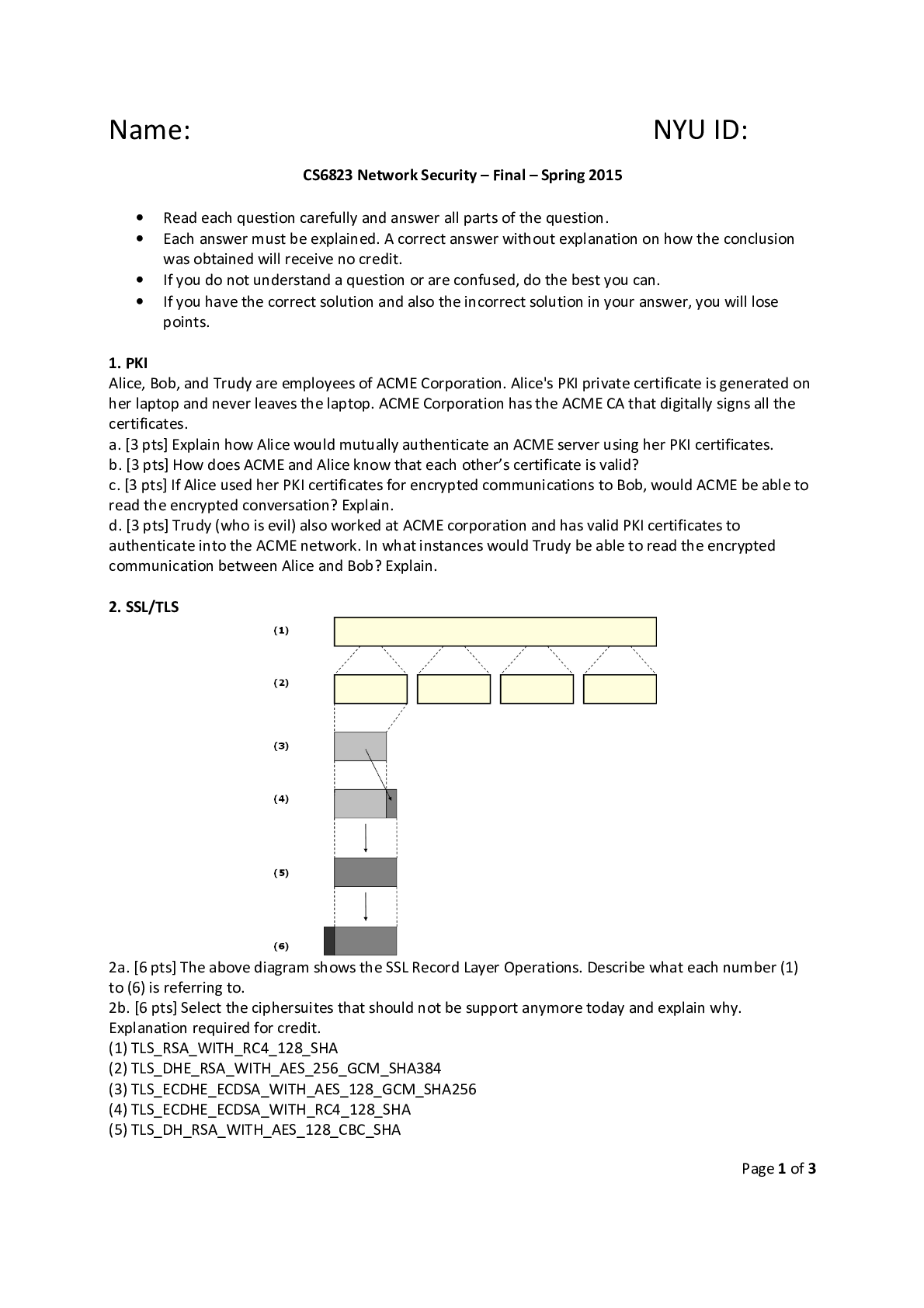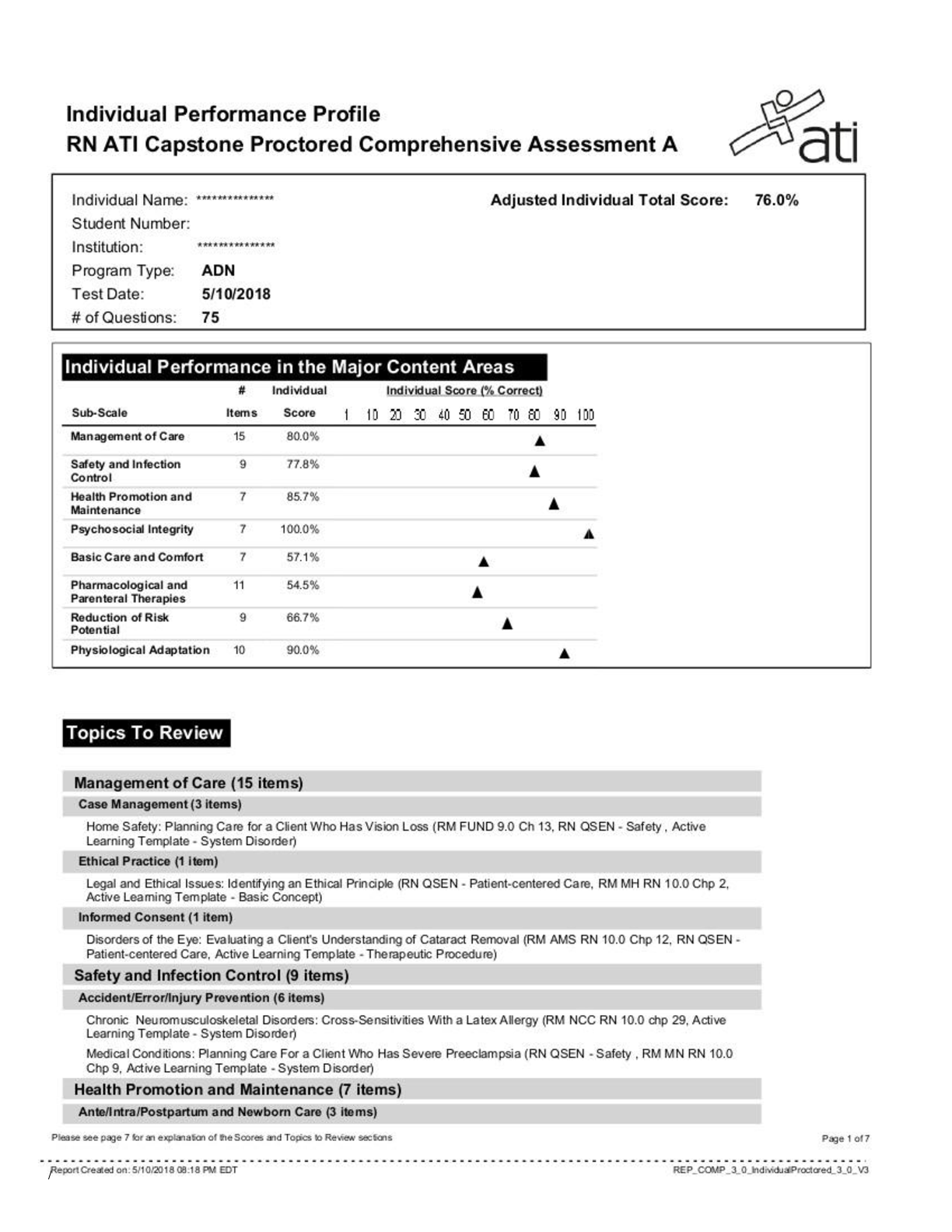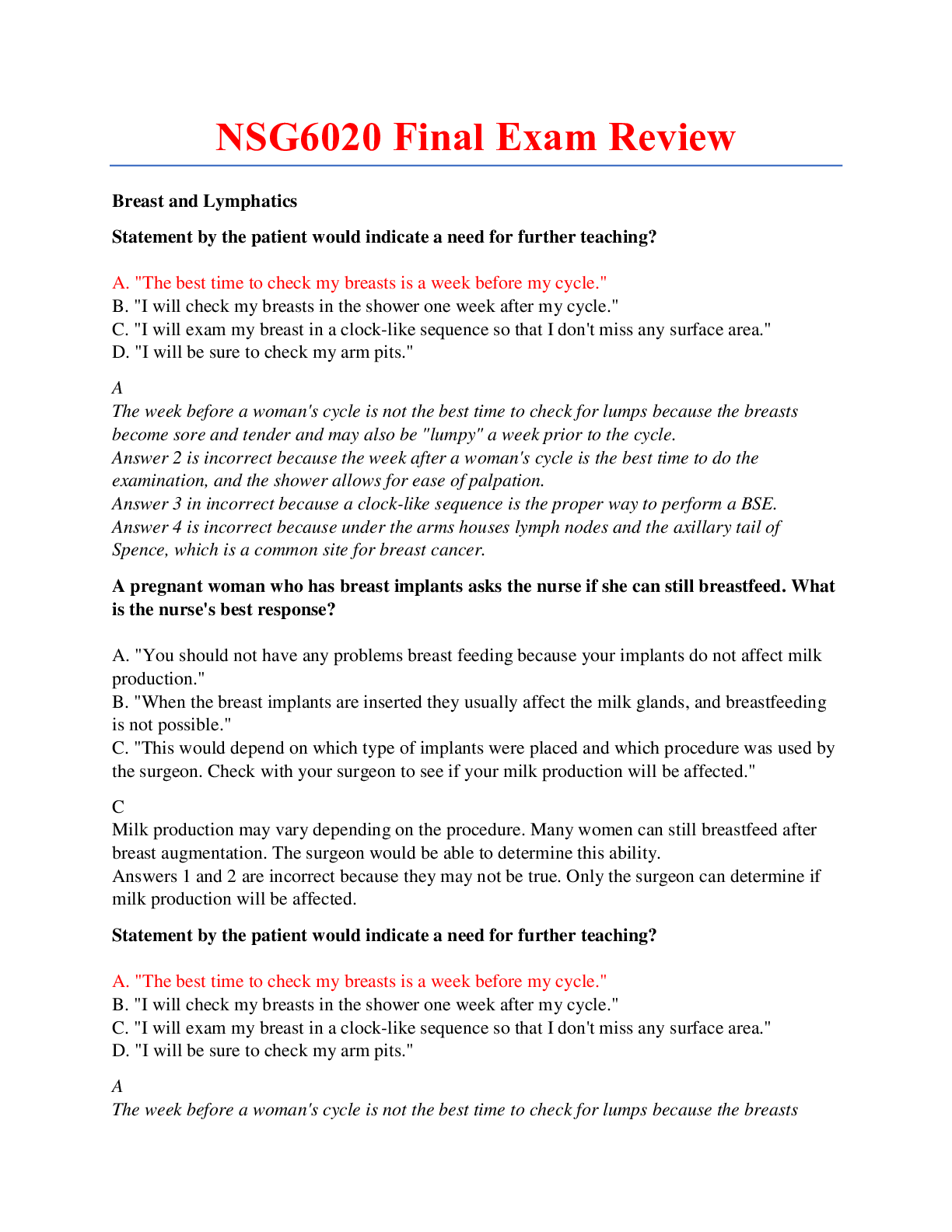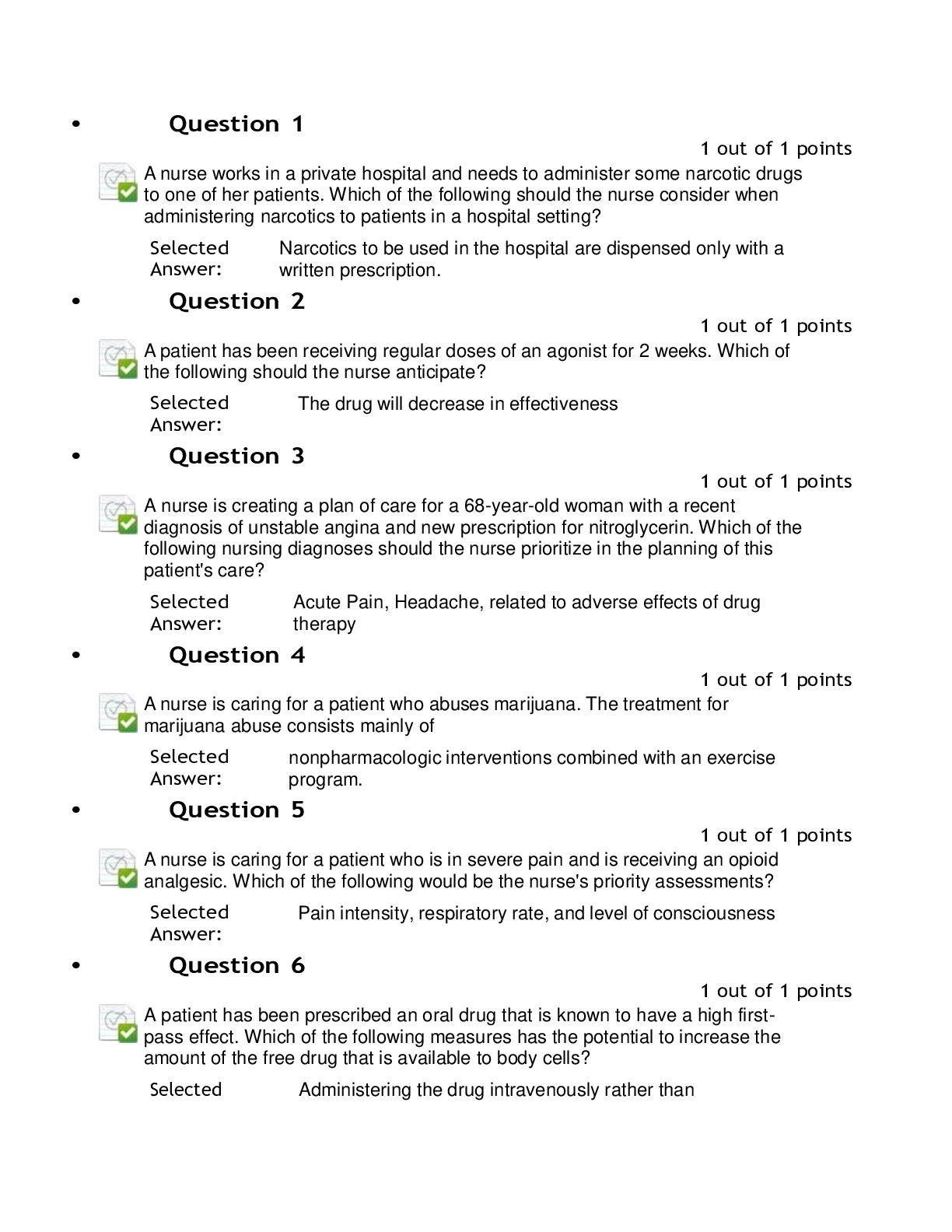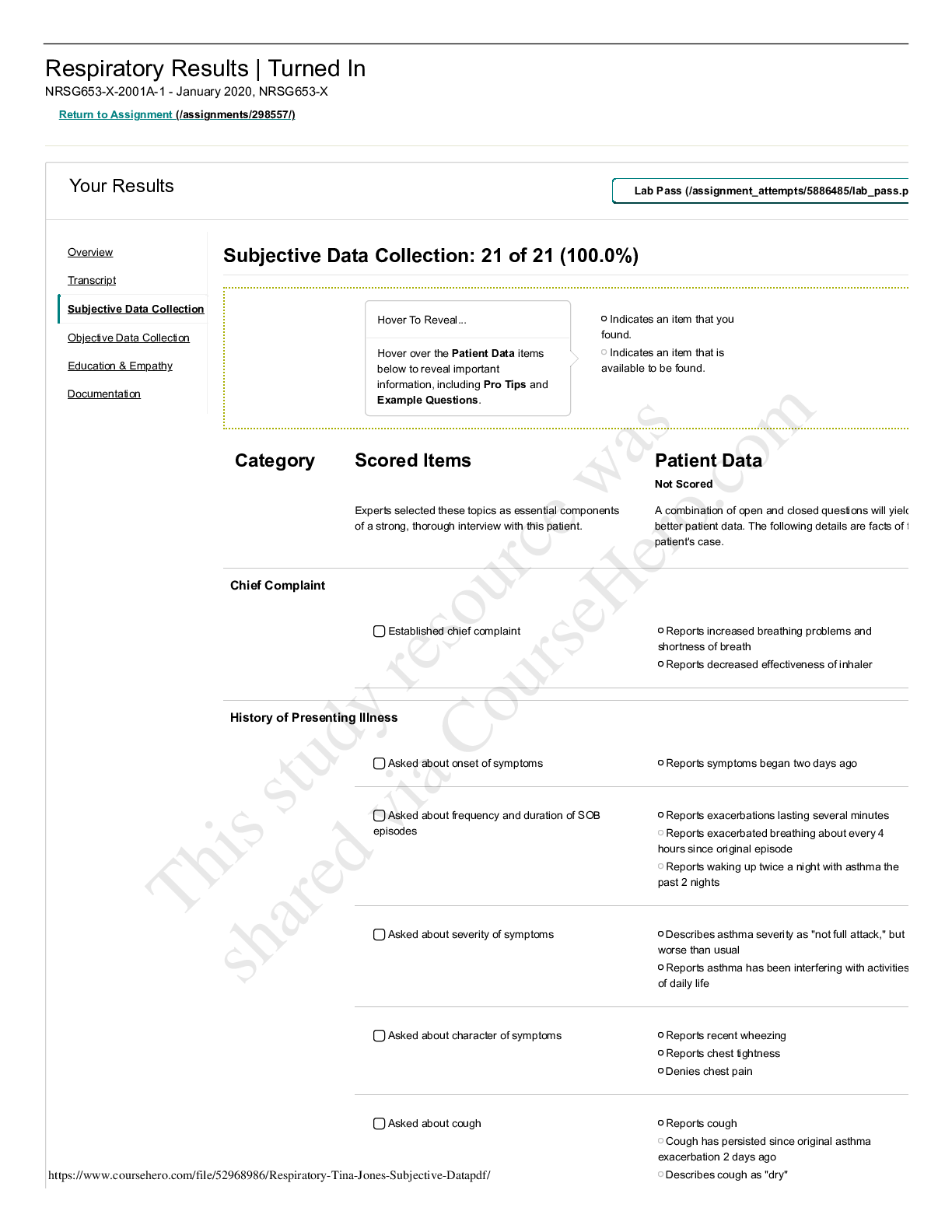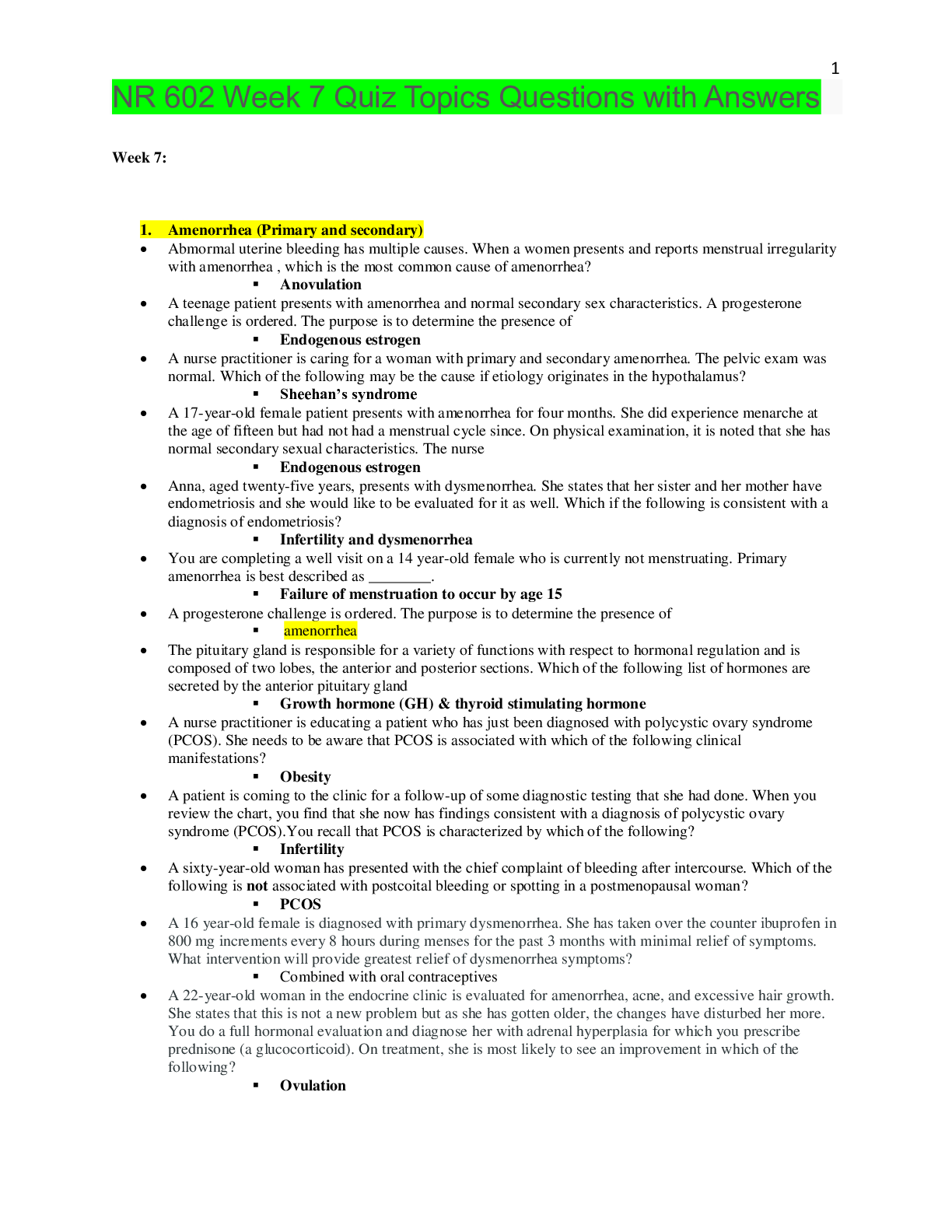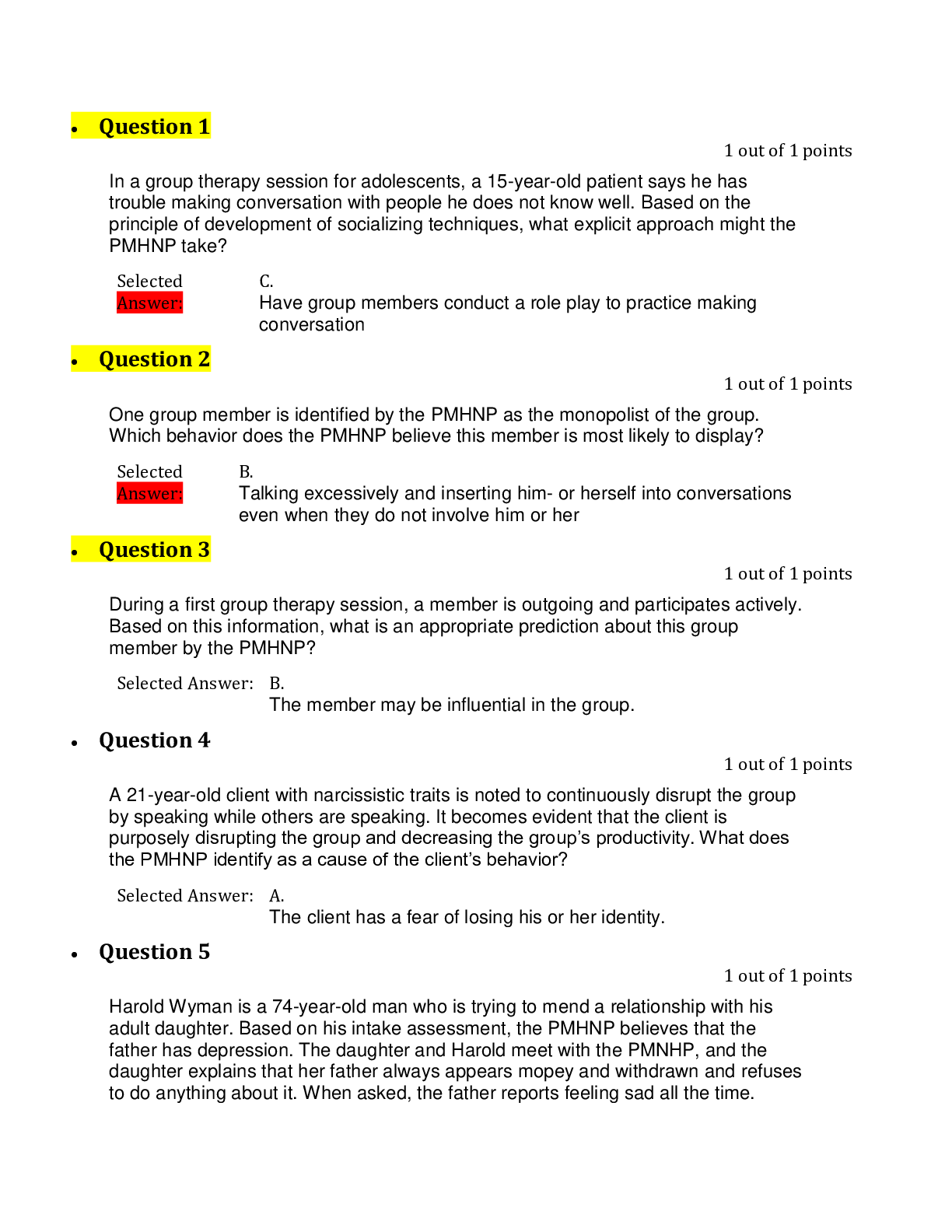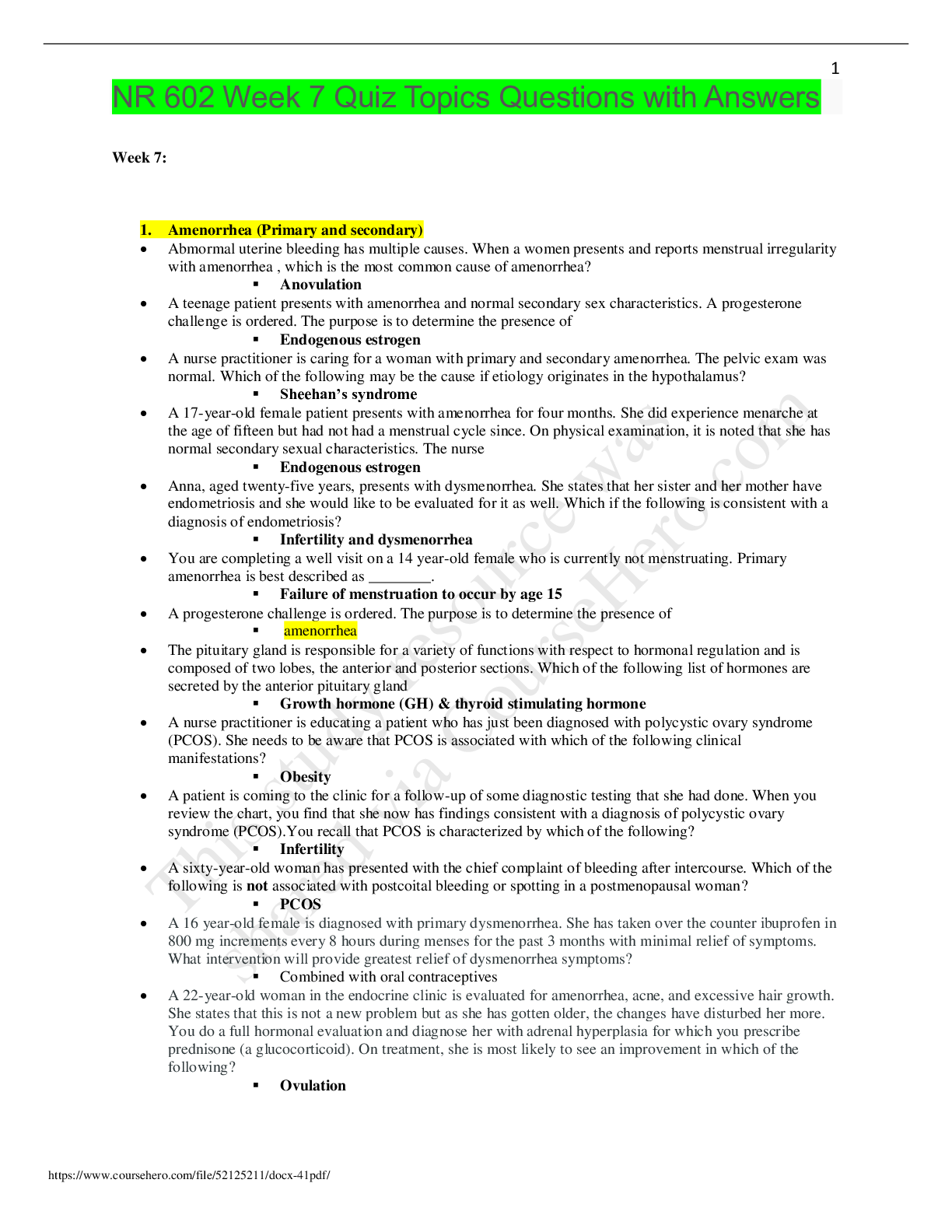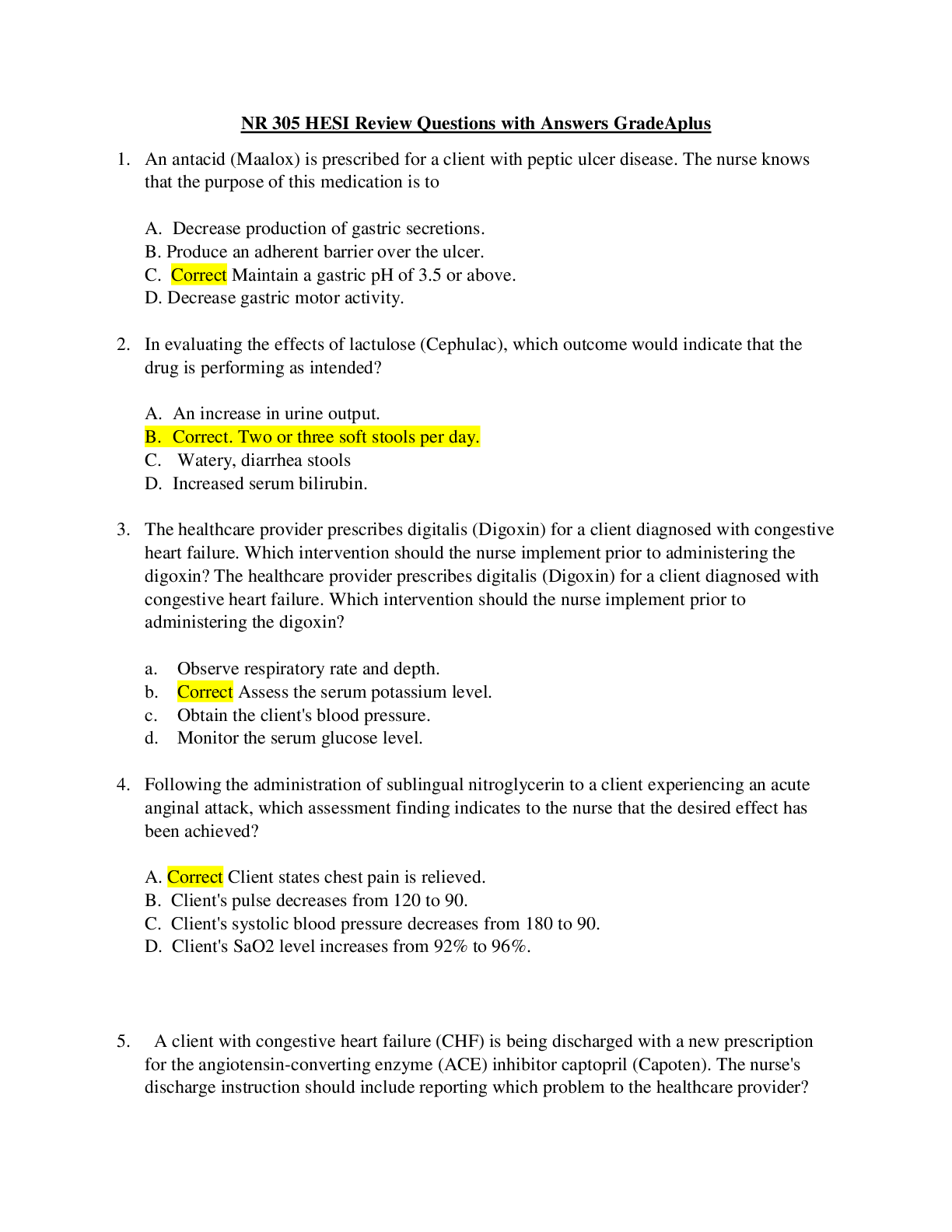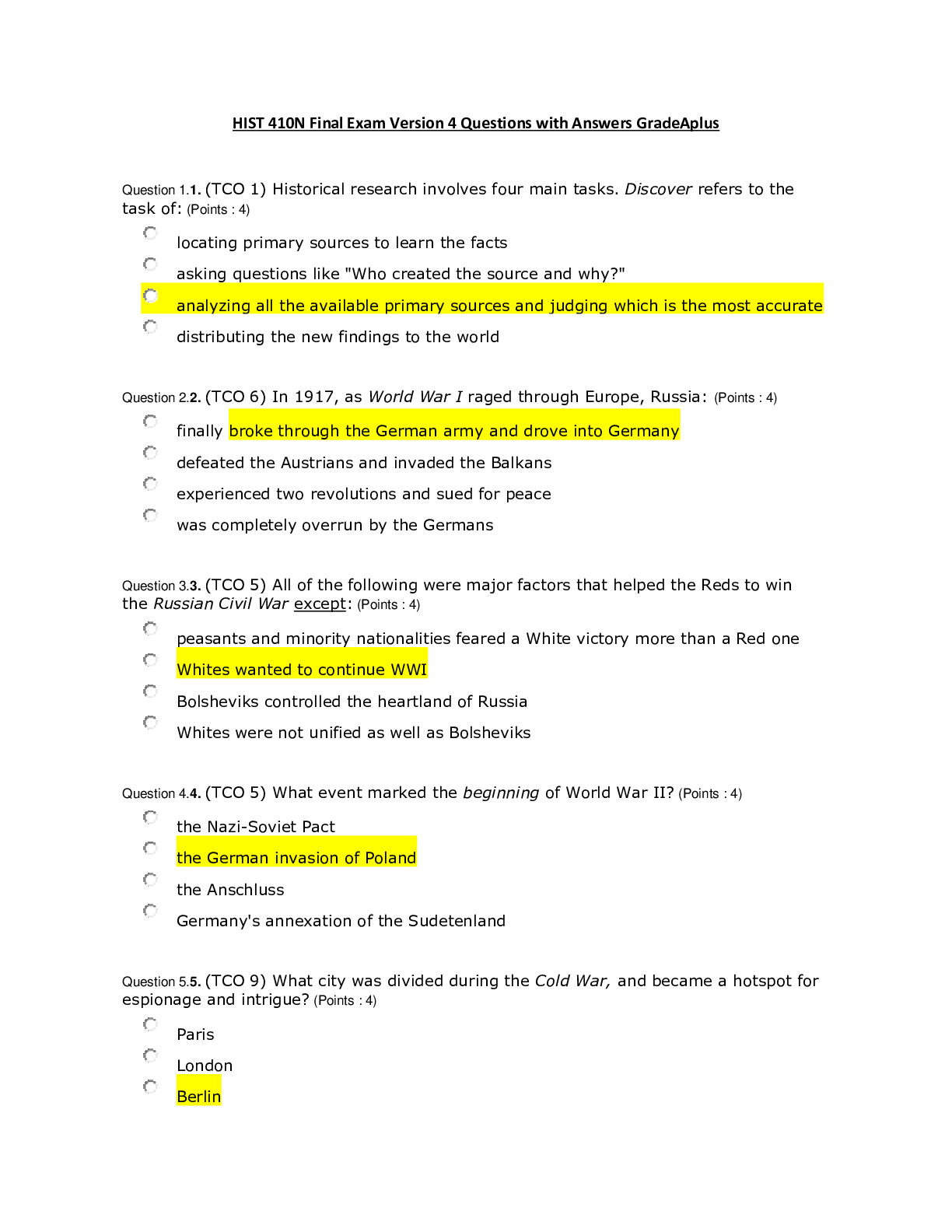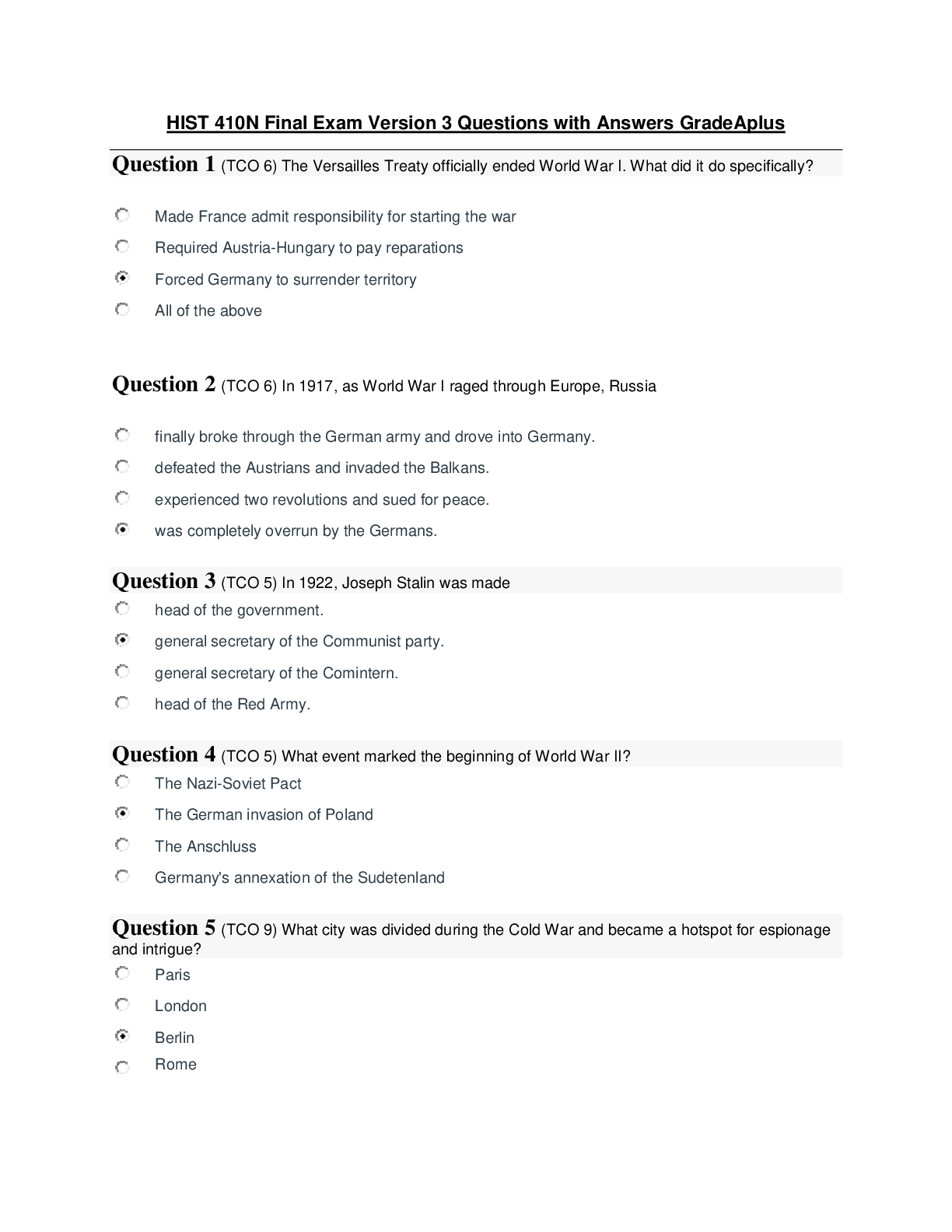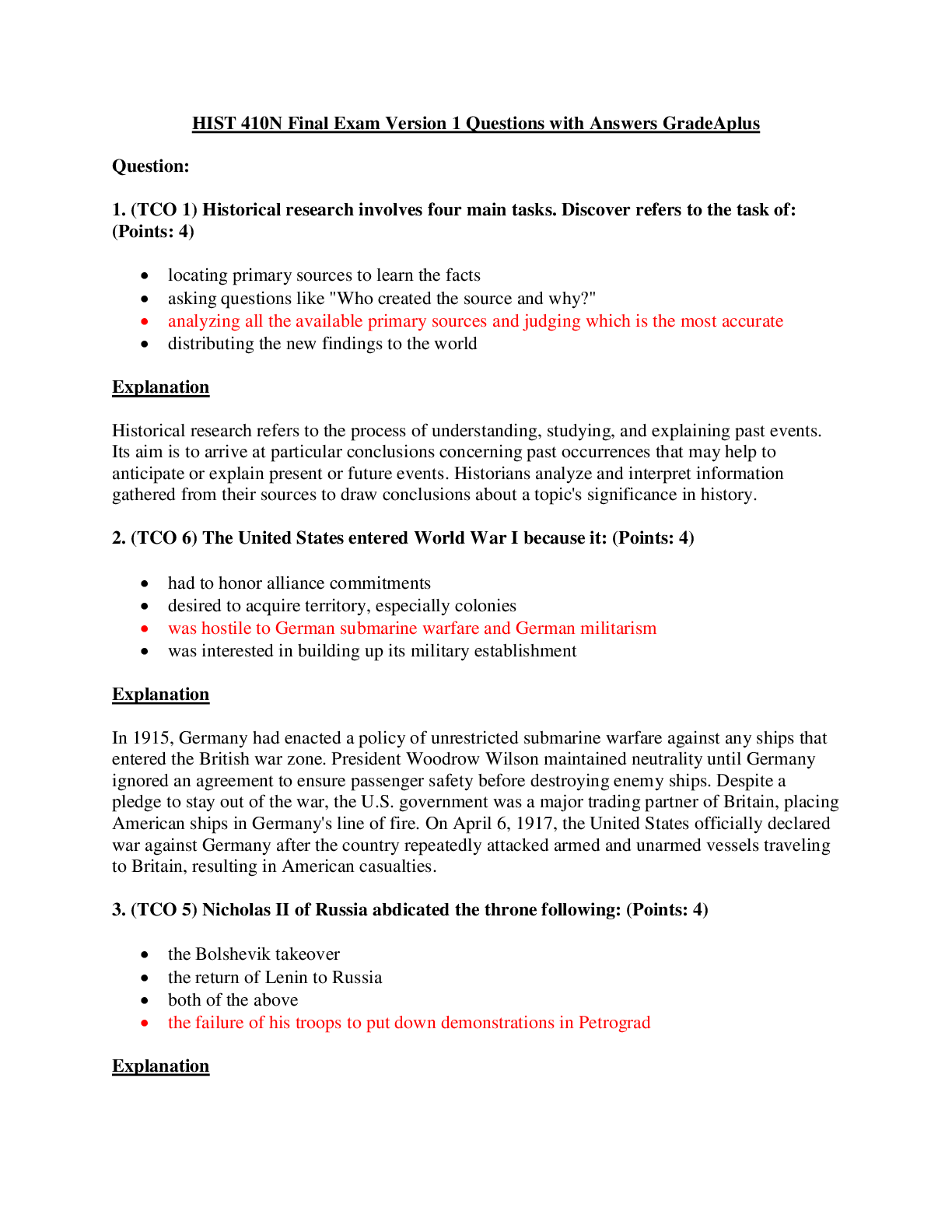*NURSING > EXAM > HESI RN V1 Pharmacology Practice Questions with Answer and Rationale..100 questions (All)
HESI RN V1 Pharmacology Practice Questions with Answer and Rationale..100 questions
Document Content and Description Below
THESE ARE THE QUESTIONS IN THIS DOCUMENT 1) A nurse is caring for a client with hyperparathyroidism and notes that the client's serum calcium level is 13 mg/dL. Which medication should the nurse... prepare to administer as prescribed to the client? 1. Calcium chloride 2. Calcium gluconate 3. Calcitonin (Miacalcin) 4. Large doses of vitamin D 2.) Oral iron supplements are prescribed for a 6-year-old child with iron deficiency anemia. The nurse instructs the mother to administer the iron with which best food item? 1. Milk 2. Water 3. Apple juice 4. Orange juice 3.) Salicylic acid is prescribed for a client with a diagnosis of psoriasis. The nurse monitors the client, knowing that which of the following would indicate the presence of systemic toxicity from this medication? 1. Tinnitus 2. Diarrhea 3. Constipation 4. Decreased respirations 4.) The camp nurse asks the children preparing to swim in the lake if they have applied sunscreen. The nurse reminds the children that chemical sunscreens are most effective when applied: 1. Immediately before swimming 2. 15 minutes before exposure to the sun 3. Immediately before exposure to the sun 4. At least 30 minutes before exposure to the sun 5.) Mafenide acetate (Sulfamylon) is prescribed for the client with a burn injury. When applying the medication, the client complains of local discomfort and burning. Which of the following is the most appropriate nursing action? 1. Notifying the registered nurse 2. Discontinuing the medication 3. Informing the client that this is normal 4. Applying a thinner film than prescribed to the burn site 6.) The burn client is receiving treatments of topical mafenide acetate (Sulfamylon) to the site of injury. The nurse monitors the client, knowing that which of the following indicates that a systemic effect has occurred? 1.Hyperventilation 2.Elevated blood pressure 3.Local pain at the burn site 4.Local rash at the burn site 7.) Isotretinoin is prescribed for a client with severe acne. Before the administration of this medication, the nurse anticipates that which laboratory test will be prescribed? 1. Platelet count 2. Triglyceride level 3. Complete blood count 4. White blood cell count 8.) A client with severe acne is seen in the clinic and the health care provider (HCP) prescribes isotretinoin. The nurse reviews the client's medication record and would contact the (HCP) if the client is taking which medication? 1. Vitamin A 2. Digoxin (Lanoxin) 3. Furosemide (Lasix) 4. Phenytoin (Dilantin) 9.) The nurse is applying a topical corticosteroid to a client with eczema. The nurse would monitor for the potential for increased systemic absorption of the medication if the medication were being applied to which of the following body areas? 1. Back 2. Axilla 3. Soles of the feet 4. Palms of the hands 10.) The clinic nurse is performing an admission assessment on a client. The nurse notes that the client is taking azelaic acid (Azelex). Because of the medication prescription, the nurse would suspect that the client is being treated for: 1. Acne 2. Eczema 3. Hair loss 4. Herpes simplex 11.) The health care provider has prescribed silver sulfadiazine (Silvadene) for the client with a partial-thickness burn, which has cultured positive for gram-negative bacteria. The nurse is reinforcing information to the client about the medication. Which statement made by the client indicates a lack of understanding about the treatments? 1. "The medication is an antibacterial." 2. "The medication will help heal the burn." 3. "The medication will permanently stain my skin." 4. "The medication should be applied directly to the wound." 12.) A nurse is caring for a client who is receiving an intravenous (IV) infusion of an antineoplastic medication. During the infusion, the client complains of pain at the insertion site. During an inspection of the site, the nurse notes redness and swelling and that the rate of infusion of the medication has slowed. The nurse should take which appropriate action? 1. Notify the registered nurse. 2. Administer pain medication to reduce the discomfort. 3. Apply ice and maintain the infusion rate, as prescribed. 4. Elevate the extremity of the IV site, and slow the infusion. 13.) The client with squamous cell carcinoma of the larynx is receiving bleomycin intravenously. The nurse caring for the client anticipates that which diagnostic study will be prescribed? 1. Echocardiography 2. Electrocardiography 3. Cervical radiography 4. Pulmonary function studies 14.) The client with acute myelocytic leukemia is being treated with busulfan (Myleran). Which laboratory value would the nurse specifically monitor during treatment with this medication? 1. Clotting time 2. Uric acid level 3. Potassium level 4. Blood glucose level 15.) The client with small cell lung cancer is being treated with etoposide (VePesid). The nurse who is assisting in caring for the client during its administration understands that which side effect is specifically associated with this medication? 1. Alopecia 2. Chest pain 3. Pulmonary fibrosis 4. Orthostatic hypotension 16.) The clinic nurse is reviewing a teaching plan for the client receiving an antineoplastic medication. When implementing the plan, the nurse tells the client: 1. To take aspirin (acetylsalicylic acid) as needed for headache 2. Drink beverages containing alcohol in moderate amounts each evening 3. Consult with health care providers (HCPs) before receiving immunizations 4. That it is not necessary to consult HCPs before receiving a flu vaccine at the local health fair 17.) The client with ovarian cancer is being treated with vincristine (Oncovin). The nurse monitors the client, knowing that which of the following indicates a side effect specific to this medication? 1. Diarrhea 2. Hair loss 3. Chest pain 4. Numbness and tingling in the fingers and toes 18.) The nurse is reviewing the history and physical examination of a client who will be receiving asparaginase (Elspar), an antineoplastic agent. The nurse consults with the registered nurse regarding the administration of the medication if which of the following is documented in the client's history? 1. Pancreatitis 2. Diabetes mellitus 3. Myocardial infarction 4. Chronic obstructive pulmonary disease 19.) Tamoxifen is prescribed for the client with metastatic breast carcinoma. The nurse understands that the primary action of this medication is to: 1. Increase DNA and RNA synthesis. 2. Promote the biosynthesis of nucleic acids. 3. Increase estrogen concentration and estrogen response. 4. Compete with estradiol for binding to estrogen in tissues containing high concentrations of receptors. 20.) The client with metastatic breast cancer is receiving tamoxifen. The nurse specifically monitors which laboratory value while the client is taking this medication? 1. Glucose level 2. Calcium level 3. Potassium level 4. Prothrombin time 21.) A nurse is assisting with caring for a client with cancer who is receiving cisplatin. Select the adverse effects that the nurse monitors for that are associated with this medication. Select all that apply. 1. Tinnitus 2. Ototoxicity 3. Hyperkalemia 4. Hypercalcemia 5. Nephrotoxicity 6. Hypomagnesemia 22.) A nurse is caring for a client after thyroidectomy and notes that calcium gluconate is prescribed for the client. The nurse determines that this medication has been prescribed to: 1. Treat thyroid storm. 2. Prevent cardiac irritability. 3. Treat hypocalcemic tetany. 4. Stimulate the release of parathyroid hormone. 23.) A client who has been newly diagnosed with diabetes mellitus has been stabilized with daily insulin injections. Which information should the nurse teach when carrying out plans for discharge? 1. Keep insulin vials refrigerated at all times. 2. Rotate the insulin injection sites systematically. 3. Increase the amount of insulin before unusual exercise. 4. Monitor the urine acetone level to determine the insulin dosage. 24.) A nurse is reinforcing teaching for a client regarding how to mix regular insulin and NPH insulin in the same syringe. Which of the following actions, if performed by the client, indicates the need for further teaching? 1. Withdraws the NPH insulin first 2. Withdraws the regular insulin first 3. Injects air into NPH insulin vial first 4. Injects an amount of air equal to the desired dose of insulin into the vial 25.) A home care nurse visits a client recently diagnosed with diabetes mellitus who is taking Humulin NPH insulin daily. The client asks the nurse how to store the unopened vials of insulin. The nurse tells the client to: 1. Freeze the insulin. 2. Refrigerate the insulin. 3. Store the insulin in a dark, dry place. 4. Keep the insulin at room temperature. 26.) Glimepiride (Amaryl) is prescribed for a client with diabetes mellitus. A nurse reinforces instructions for the client and tells the client to avoid which of the following while taking this medication? 1. Alcohol 2. Organ meats 3. Whole-grain cereals 4. Carbonated beverages . 27.) Sildenafil (Viagra) is prescribed to treat a client with erectile dysfunction. A nurse reviews the client's medical record and would question the prescription if which of the following is noted in the client's history? 1. Neuralgia 2. Insomnia 3. Use of nitroglycerin 4. Use of multivitamins 28.) The health care provider (HCP) prescribes exenatide (Byetta) for a client with type 1 diabetes mellitus who takes insulin. The nurse knows that which of the following is the appropriate intervention? 1. The medication is administered within 60 minutes before the morning and evening meal. 2. The medication is withheld and the HCP is called to question the prescription for the client. 3. The client is monitored for gastrointestinal side effects after administration of the medication. 4. The insulin is withdrawn from the Penlet into an insulin syringe to prepare for administration. 29.) A client is taking Humulin NPH insulin daily every morning. The nurse reinforces instructions for the client and tells the client that the most likely time for a hypoglycemic reaction to occur is: 1. 2 to 4 hours after administration 2. 4 to 12 hours after administration 3. 16 to 18 hours after administration 4. 18 to 24 hours after administration 30.) A client with diabetes mellitus visits a health care clinic. The client's diabetes mellitus previously had been well controlled with glyburide (DiaBeta) daily, but recently the fasting blood glucose level has been 180 to 200 mg/dL. Which medication, if added to the client's regimen, may have contributed to the hyperglycemia? 1. Prednisone 2. Phenelzine (Nardil) 3. Atenolol (Tenormin) 4. Allopurinol (Zyloprim) 31.) A community health nurse visits a client at home. Prednisone 10 mg orally daily has been prescribed for the client and the nurse reinforces teaching for the client about the medication. Which statement, if made by the client, indicates that further teaching is necessary? 1. "I can take aspirin or my antihistamine if I need it." 2. "I need to take the medication every day at the same time." 3. "I need to avoid coffee, tea, cola, and chocolate in my diet." 4. "If I gain more than 5 pounds a week, I will call my doctor." 32.) Desmopressin acetate (DDAVP) is prescribed for the treatment of diabetes insipidus. The nurse monitors the client after medication administration for which therapeutic response? 1. Decreased urinary output 2. Decreased blood pressure 3. Decreased peripheral edema 4. Decreased blood glucose level 33.) The home health care nurse is visiting a client who was recently diagnosed with type 2 diabetes mellitus. The client is prescribed repaglinide (Prandin) and metformin (Glucophage) and asks the nurse to explain these medications. The nurse should reinforce which instructions to the client? Select all that apply. 1. Diarrhea can occur secondary to the metformin. 2. The repaglinide is not taken if a meal is skipped. 3. The repaglinide is taken 30 minutes before eating. 4. Candy or another simple sugar is carried and used to treat mild hypoglycemia episodes. 5. Metformin increases hepatic glucose production to prevent hypoglycemia associated with repaglinide. 6. Muscle pain is an expected side effect of metformin and may be treated with acetaminophen (Tylenol). 1. Diarrhea can occur secondary to the metformin. 34.) A client with Crohn's disease is scheduled to receive an infusion of infliximab (Remicade). The nurse assisting in caring for the client should take which action to monitor the effectiveness of treatment? 1. Monitoring the leukocyte count for 2 days after the infusion 2. Checking the frequency and consistency of bowel movements 3. Checking serum liver enzyme levels before and after the infusion 4. Carrying out a Hematest on gastric fluids after the infusion is completed 35.) The client has a PRN prescription for loperamide hydrochloride (Imodium). The nurse understands that this medication is used for which condition? 1. Constipation 2. Abdominal pain 3. An episode of diarrhea 4. Hematest-positive nasogastric tube drainage 36.) The client has a PRN prescription for ondansetron (Zofran). For which condition should this medication be administered to the postoperative client? 1. Paralytic ileus 2. Incisional pain 3. Urinary retention 4. Nausea and vomiting 37.) The client has begun medication therapy with pancrelipase (Pancrease MT). The nurse evaluates that the medication is having the optimal intended benefit if which effect is observed? 1. Weight loss 2. Relief of heartburn 3. Reduction of steatorrhea 4. Absence of abdominal pain 38.) An older client recently has been taking cimetidine (Tagamet). The nurse monitors the client for which most frequent central nervous system side effect of this medication? 1. Tremors 2. Dizziness 3. Confusion 4. Hallucinations 39.) The client with a gastric ulcer has a prescription for sucralfate (Carafate), 1 g by mouth four times daily. The nurse schedules the medication for which times? 1. With meals and at bedtime 2. Every 6 hours around the clock 3. One hour after meals and at bedtime 4. One hour before meals and at bedtime 40.) The client who chronically uses nonsteroidal anti-inflammatory drugs has been taking misoprostol (Cytotec). The nurse determines that the medication is having the intended therapeutic effect if which of the following is noted? 1. Resolved diarrhea 2. Relief of epigastric pain 3. Decreased platelet count 4. Decreased white blood cell count 41.) The client has been taking omeprazole (Prilosec) for 4 weeks. The ambulatory care nurse evaluates that the client is receiving optimal intended effect of the medication if the client reports the absence of which symptom? 1. Diarrhea 2. Heartburn 3. Flatulence 4. Constipation 42.) A client with a peptic ulcer is diagnosed with a Helicobacter pylori infection. The nurse is reinforcing teaching for the client about the medications prescribed, including clarithromycin (Biaxin), esomeprazole (Nexium), and amoxicillin (Amoxil). Which statement by the client indicates the best understanding of the medication regimen? 1. "My ulcer will heal because these medications will kill the bacteria." 2. "These medications are only taken when I have pain from my ulcer." 3. "The medications will kill the bacteria and stop the acid production." 4. "These medications will coat the ulcer and decrease the acid production in my stomach." 43.) A histamine (H2)-receptor antagonist will be prescribed for a client. The nurse understands that which medications are H2-receptor antagonists? Select all that apply. 1. Nizatidine (Axid) 2. Ranitidine (Zantac) 3. Famotidine (Pepcid) 4. Cimetidine (Tagamet) 5. Esomeprazole (Nexium) 6. Lansoprazole (Prevacid) 1. Nizatidine (Axid) 44.) A client is receiving acetylcysteine (Mucomyst), 20% solution diluted in 0.9% normal saline by nebulizer. The nurse should have which item available for possible use after giving this medication? 1. Ambu bag 2. Intubation tray 3. Nasogastric tube 4. Suction equipment 45.) A client has a prescription to take guaifenesin (Humibid) every 4 hours, as needed. The nurse determines that the client understands the most effective use of this medication if the client states that he or she will: 1. Watch for irritability as a side effect. 2. Take the tablet with a full glass of water. 3. Take an extra dose if the cough is accompanied by fever. 4. Crush the sustained-release tablet if immediate relief is needed. 46.) A postoperative client has received a dose of naloxone hydrochloride for respiratory depression shortly after transfer to the nursing unit from the postanesthesia care unit. After administration of the medication, the nurse checks the client for: 1. Pupillary changes 2. Scattered lung wheezes 3. Sudden increase in pain 4. Sudden episodes of diarrhea 47.) A client has been taking isoniazid (INH) for 2 months. The client complains to a nurse about numbness, paresthesias, and tingling in the extremities. The nurse interprets that the client is experiencing: 1. Hypercalcemia 2. Peripheral neuritis 3. Small blood vessel spasm 4. Impaired peripheral circulation 48.) A client is to begin a 6-month course of therapy with isoniazid (INH). A nurse plans to teach the client to: 1. Drink alcohol in small amounts only. 2. Report yellow eyes or skin immediately. 3. Increase intake of Swiss or aged cheeses. 4. Avoid vitamin supplements during therapy. 49.) A client has been started on long-term therapy with rifampin (Rifadin). A nurse teaches the client that the medication: 1. Should always be taken with food or antacids 2. Should be double-dosed if one dose is forgotten 3. Causes orange discoloration of sweat, tears, urine, and feces 4. May be discontinued independently if symptoms are gone in 3 months 50.) A nurse has given a client taking ethambutol (Myambutol) information about the medication. The nurse determines that the client understands the instructions if the client states that he or she will immediately report: 1. Impaired sense of hearing 2. Problems with visual acuity 3. Gastrointestinal (GI) side effects 4. Orange-red discoloration of body secretions 51.) Cycloserine (Seromycin) is added to the medication regimen for a client with tuberculosis. Which of the following would the nurse include in the client-teaching plan regarding this medication? 1. To take the medication before meals 2. To return to the clinic weekly for serum drug-level testing 3. It is not necessary to call the health care provider (HCP) if a skin rash occurs. 4. It is not necessary to restrict alcohol intake with this medication. 52.) A client with tuberculosis is being started on antituberculosis therapy with isoniazid (INH). Before giving the client the first dose, a nurse ensures that which of the following baseline studies has been completed? 1. Electrolyte levels 2. Coagulation times 3. Liver enzyme levels 4. Serum creatinine level 53.) Rifabutin (Mycobutin) is prescribed for a client with active Mycobacterium avium complex (MAC) disease and tuberculosis. The nurse monitors for which side effects of the medication? Select all that apply. 1. Signs of hepatitis 2. Flu-like syndrome 3. Low neutrophil count 4. Vitamin B6 deficiency 5. Ocular pain or blurred vision 6. Tingling and numbness of the fingers 1. Signs of hepatitis 54.) A nurse reinforces discharge instructions to a postoperative client who is taking warfarin sodium (Coumadin). Which statement, if made by the client, reflects the need for further teaching? 1. "I will take my pills every day at the same time." 2. "I will be certain to avoid alcohol consumption." 3. "I have already called my family to pick up a Medic-Alert bracelet." 4. "I will take Ecotrin (enteric-coated aspirin) for my headaches because it is coated." 55.) A client who is receiving digoxin (Lanoxin) daily has a serum potassium level of 3.0 mEq/L and is complaining of anorexia. A health care provider prescribes a digoxin level to rule out digoxin toxicity. A nurse checks the results, knowing that which of the following is the therapeutic serum level (range) for digoxin? 1. 3 to 5 ng/mL 2. 0.5 to 2 ng/mL 3. 1.2 to 2.8 ng/mL 4. 3.5 to 5.5 ng/mL 56.) Heparin sodium is prescribed for the client. The nurse expects that the health care provider will prescribe which of the following to monitor for a therapeutic effect of the medication? 1. Hematocrit level 2. Hemoglobin level 3. Prothrombin time (PT) 4. Activated partial thromboplastin time (aPTT) 57.) A nurse is monitoring a client who is taking propranolol (Inderal LA). Which data collection finding would indicate a potential serious complication associated with propranolol? 1. The development of complaints of insomnia 2. The development of audible expiratory wheezes 3. A baseline blood pressure of 150/80 mm Hg followed by a blood pressure of 138/72 mm Hg after two doses of the medication 4. A baseline resting heart rate of 88 beats/min followed by a resting heart rate of 72 beats/min after two doses of the medication 58.) Isosorbide mononitrate (Imdur) is prescribed for a client with angina pectoris. The client tells the nurse that the medication is causing a chronic headache. The nurse appropriately suggests that the client: 1. Cut the dose in half. 2. Discontinue the medication. 3. Take the medication with food. 4. Contact the health care provider (HCP). 59.) A client is diagnosed with an acute myocardial infarction and is receiving tissue plasminogen activator, alteplase (Activase, tPA). Which action is a priority nursing intervention? 1. Monitor for renal failure. 2. Monitor psychosocial status. 3. Monitor for signs of bleeding. 4. Have heparin sodium available. 60.) A nurse is planning to administer hydrochlorothiazide (HydroDIURIL) to a client. The nurse understands that which of the following are concerns related to the administration of this medication? 1. Hypouricemia, hyperkalemia 2. Increased risk of osteoporosis 3. Hypokalemia, hyperglycemia, sulfa allergy 4. Hyperkalemia, hypoglycemia, penicillin allergy 61.) A home health care nurse is visiting a client with elevated triglyceride levels and a serum cholesterol level of 398 mg/dL. The client is taking cholestyramine (Questran). Which of the following statements, if made by the client, indicates the need for further education? 1. "Constipation and bloating might be a problem." 2. "I'll continue to watch my diet and reduce my fats." 3. "Walking a mile each day will help the whole process." 4. "I'll continue my nicotinic acid from the health food store." 62.) A client is on nicotinic acid (niacin) for hyperlipidemia and the nurse provides instructions to the client about the medication. Which statement by the client would indicate an understanding of the instructions? 1. "It is not necessary to avoid the use of alcohol." 2. "The medication should be taken with meals to decrease flushing." 3. "Clay-colored stools are a common side effect and should not be of concern." 4. "Ibuprofen (Motrin) taken 30 minutes before the nicotinic acid should decrease the flushing." 63.) A client with coronary artery disease complains of substernal chest pain. After checking the client's heart rate and blood pressure, a nurse administers nitroglycerin, 0.4 mg, sublingually. After 5 minutes, the client states, "My chest still hurts." Select the appropriate actions that the nurse should take. Select all that apply. 1. Call a code blue. 2. Contact the registered nurse. 3. Contact the client's family. 4. Assess the client's pain level. 5. Check the client's blood pressure. 6. Administer a second nitroglycerin, 0.4 mg, sublingually. 2. Contact the registered nurse. 64.) Nalidixic acid (NegGram) is prescribed for a client with a urinary tract infection. On review of the client's record, the nurse notes that the client is taking warfarin sodium (Coumadin) daily. Which prescription should the nurse anticipate for this client? 1. Discontinuation of warfarin sodium (Coumadin) 2. A decrease in the warfarin sodium (Coumadin) dosage 3. An increase in the warfarin sodium (Coumadin) dosage 4. A decrease in the usual dose of nalidixic acid (NegGram) 65.) A nurse is reinforcing discharge instructions to a client receiving sulfisoxazole. Which of the following should be included in the list of instructions? 1. Restrict fluid intake. 2. Maintain a high fluid intake. 3. If the urine turns dark brown, call the health care provider (HCP) immediately. 4. Decrease the dosage when symptoms are improving to prevent an allergic response. 66.) Trimethoprim-sulfamethoxazole (TMP-SMZ) is prescribed for a client. A nurse should instruct the client to report which symptom if it developed during the course of this medication therapy? 1. Nausea 2. Diarrhea 3. Headache 4. Sore throat 67.) Phenazopyridine hydrochloride (Pyridium) is prescribed for a client for symptomatic relief of pain resulting from a lower urinary tract infection. The nurse reinforces to the client: 1. To take the medication at bedtime 2. To take the medication before meals 3. To discontinue the medication if a headache occurs 4. That a reddish orange discoloration of the urine may occur 68.) Bethanechol chloride (Urecholine) is prescribed for a client with urinary retention. Which disorder would be a contraindication to the administration of this medication? 1. Gastric atony 2. Urinary strictures 3. Neurogenic atony 4. Gastroesophageal reflux 69.) A nurse who is administering bethanechol chloride (Urecholine) is monitoring for acute toxicity associated with the medication. The nurse checks the client for which sign of toxicity? 1. Dry skin 2. Dry mouth 3. Bradycardia 4. Signs of dehydration 70.) Oxybutynin chloride (Ditropan XL) is prescribed for a client with neurogenic bladder. Which sign would indicate a possible toxic effect related to this medication? 1. Pallor 2. Drowsiness 3. Bradycardia 4. Restlessness 71.) After kidney transplantation, cyclosporine (Sand immune) is prescribed for a client. Which laboratory result would indicate an adverse effect from the use of this medication? 1. Decreased creatinine level 2. Decreased hemoglobin level 3. Elevated blood urea nitrogen level 4. Decreased white blood cell count 72.) Cinoxacin (Cinobac), a urinary antiseptic, is prescribed for the client. The nurse reviews the client's medical record and should contact the health care provider (HCP) regarding which documented finding to verify the prescription? Refer to chart. 1. Renal insufficiency 2. Chest x-ray: normal 3. Blood glucose, 102 mg/dL 4. Folic acid (vitamin B6) 0.5 mg, orally daily 73.) A client with myasthenia gravis is suspected of having cholinergic crisis. Which of the following indicate that this crisis exists? 1. Ataxia 2. Mouth sores 3. Hypotension 4. Hypertension 74.) A client with myasthenia gravis is receiving pyridostigmine (Mestinon). The nurse monitors for signs and symptoms of cholinergic crisis caused by overdose of the medication. The nurse checks the medication supply to ensure that which medication is available for administration if a cholinergic crisis occurs? 1. Vitamin K 2. Atropine sulfate 3. Protamine sulfate 4. Acetylcysteine (Mucomyst) 75.) A client with myasthenia gravis becomes increasingly weak. The health care provider prepares to identify whether the client is reacting to an overdose of the medication (cholinergic crisis) or increasing severity of the disease (myasthenic crisis). An injection of edrophonium (Enlon) is administered. Which of the following indicates that the client is in cholinergic crisis? 1. No change in the condition 2. Complaints of muscle spasms 3. An improvement of the weakness 4. A temporary worsening of the condition 76.) Carbidopa-levodopa (Sinemet) is prescribed for a client with Parkinson's disease, and the nurse monitors the client for adverse reactions to the medication. Which of the following indicates that the client is experiencing an adverse reaction? 1. Pruritus 2. Tachycardia 3. Hypertension 4. Impaired voluntary movements 77.) Phenytoin (Dilantin), 100 mg orally three times daily, has been prescribed for a client for seizure control. The nurse reinforces instructions regarding the medication to the client. Which statement by the client indicates an understanding of the instructions? 1. "I will use a soft toothbrush to brush my teeth." 2. "It's all right to break the capsules to make it easier for me to swallow them." 3. "If I forget to take my medication, I can wait until the next dose and eliminate that dose." 4. "If my throat becomes sore, it's a normal effect of the medication and it's nothing to be concerned about." 78.) A client is taking phenytoin (Dilantin) for seizure control and a sample for a serum drug level is drawn. Which of the following indicates a therapeutic serum drug range? 1. 5 to 10 mcg/mL 2. 10 to 20 mcg/mL 3. 20 to 30 mcg/mL 4. 30 to 40 mcg/mL 79.) Ibuprofen (Advil) is prescribed for a client. The nurse tells the client to take the medication: 1. With 8 oz of milk 2. In the morning after arising 3. 60 minutes before breakfast 4. At bedtime on an empty stomach 80.) A nurse is caring for a client who is taking phenytoin (Dilantin) for control of seizures. During data collection, the nurse notes that the client is taking birth control pills. Which of the following information should the nurse provide to the client? 1. Pregnancy should be avoided while taking phenytoin (Dilantin). 2. The client may stop taking the phenytoin (Dilantin) if it is causing severe gastrointestinal effects. 3. The potential for decreased effectiveness of the birth control pills exists while taking phenytoin (Dilantin). 4. The increased risk of thrombophlebitis exists while taking phenytoin (Dilantin) and birth control pills together. 81.) A client with trigeminal neuralgia is being treated with carbamazepine (Tegretol). Which laboratory result would indicate that the client is experiencing an adverse reaction to the medication? 1. Sodium level, 140 mEq/L 2. Uric acid level, 5.0 mg/dL 3. White blood cell count, 3000 cells/mm3 4. Blood urea nitrogen (BUN) level, 15 mg/dL 82.) A client is receiving meperidine hydrochloride (Demerol) for pain. Which of the following are side effects of this medication. Select all that apply. 1. Diarrhea 2. Tremors 3. Drowsiness 4. Hypotension 5. Urinary frequency 6. Increased respiratory rate 2. Tremors 3. Drowsiness 83.) The client has been on treatment for rheumatoid arthritis for 3 weeks. During the administration of etanercept (Enbrel), it is most important for the nurse to check: 1. The injection site for itching and edema 2. The white blood cell counts and platelet counts 3. Whether the client is experiencing fatigue and joint pain 4. A metallic taste in the mouth, with a loss of appetite 84.) Baclofen (Lioresal) is prescribed for the client with multiple sclerosis. The nurse assists in planning care, knowing that the primary therapeutic effect of this medication is which of the following? 1. Increased muscle tone 2. Decreased muscle spasms 3. Increased range of motion 4. Decreased local pain and tenderness 85.) A nurse is monitoring a client receiving baclofen (Lioresal) for side effects related to the medication. Which of the following would indicate that the client is experiencing a side effect? 1. Polyuria 2. Diarrhea 3. Drowsiness 4. Muscular excitability 86.) A nurse is reinforcing discharge instructions to a client receiving baclofen (Lioresal). Which of the following would the nurse include in the instructions? 1. Restrict fluid intake. 2. Avoid the use of alcohol. 3. Stop the medication if diarrhea occurs. 4. Notify the health care provider if fatigue occurs. 2. Avoid the use of alcohol. 87.) A client with acute muscle spasms has been taking baclofen (Lioresal). The client calls the clinic nurse because of continuous feelings of weakness and fatigue and asks the nurse about discontinuing the medication. The nurse should make which appropriate response to the client? 1. "You should never stop the medication." 2. "It is best that you taper the dose if you intend to stop the medication." 3. "It is okay to stop the medication if you think that you can tolerate the muscle spasms." 4. "Weakness and fatigue commonly occur and will diminish with continued medication use." 88.) Dantrolene sodium (Dantrium) is prescribed for a client experiencing flexor spasms, and the client asks the nurse about the action of the medication. The nurse responds, knowing that the therapeutic action of this medication is which of the following? 1. Depresses spinal reflexes 2. Acts directly on the skeletal muscle to relieve spasticity 3. Acts within the spinal cord to suppress hyperactive reflexes 4. Acts on the central nervous system (CNS) to suppress spasms 89.) A nurse is reviewing the laboratory studies on a client receiving dantrolene sodium (Dantrium). Which laboratory test would identify an adverse effect associated with the administration of this medication? 1. Creatinine 2. Liver function tests 3. Blood urea nitrogen 4. Hematological function tests 90.) A nurse is reviewing the record of a client who has been prescribed baclofen (Lioresal). Which of the following disorders, if noted in the client's history, would alert the nurse to contact the health care provider? 1. Seizure disorders 2. Hyperthyroidism 3. Diabetes mellitus 4. Coronary artery disease 91.) Cyclobenzaprine (Flexeril) is prescribed for a client to treat muscle spasms, and the nurse is reviewing the client's record. Which of the following disorders, if noted in the client's record, would indicate a need to contact the health care provider regarding the administration of this medication? 1. Glaucoma 2. Emphysema 3. Hyperthyroidism 4. Diabetes mellitus 92.) In monitoring a client's response to disease-modifying antirheumatic drugs (DMARDs), which findings would the nurse interpret as acceptable responses? Select all that apply. 1. Symptom control during periods of emotional stress 2. Normal white blood cell counts, platelet, and neutrophil counts 3. Radiological findings that show nonprogression of joint degeneration 4. An increased range of motion in the affected joints 3 months into therapy 5. Inflammation and irritation at the injection site 3 days after injection is given 6. A low-grade temperature upon rising in the morning that remains throughout the day 1. Symptom control during periods of emotional stress 2. Normal white blood cell counts, platelet, and neutrophil counts 3. Radiological findings that show nonprogression of joint degeneration 4. An increased range of motion in the affected joints 93.) The client who is human immunodeficiency virus seropositive has been taking stavudine (d4t, Zerit). The nurse monitors which of the following most closely while the client is taking this medication? 1. Gait 2. Appetite 3. Level of consciousness 4. Hemoglobin and hematocrit blood levels 94.) The client with acquired immunodeficiency syndrome has begun therapy with zidovudine (Retrovir, Azidothymidine, AZT, ZDV). The nurse carefully monitors which of the following laboratory results during treatment with this medication? 1. Blood culture 2. Blood glucose level 3. Blood urea nitrogen 4. Complete blood count 4. . 95.) The nurse is reviewing the results of serum laboratory studies drawn on a client with acquired immunodeficiency syndrome who is receiving didanosine (Videx). The nurse interprets that the client may have the medication discontinued by the health care provider if which of the following significantly elevated results is noted? 1. Serum protein 2. Blood glucose 3. Serum amylase 4. Serum creatinine 96.) The nurse is caring for a postrenal transplant client taking cyclosporine (Sandimmune, Gengraf, Neoral). The nurse notes an increase in one of the client's vital signs, and the client is complaining of a headache. What is the vital sign that is most likely increased? 1. Pulse 2. Respirations 3. Blood pressure 4. Pulse oximetry 3. 97.) Amikacin (Amikin) is prescribed for a client with a bacterial infection. The client is instructed to contact the health care provider (HCP) immediately if which of the following occurs? 1. Nausea 2. Lethargy 3. Hearing loss 4. Muscle aches 3. 98.) The nurse is assigned to care for a client with cytomegalovirus retinitis and acquired immunodeficiency syndrome who is receiving foscarnet. The nurse should check the latest results of which of the following laboratory studies while the client is taking this medication? 1. CD4 cell count 2. Serum albumin 3. Serum creatinine 4. Lymphocyte count 99.) The client with acquired immunodeficiency syndrome and Pneumocystis jiroveci infection has been receiving pentamidine isethionate (Pentam 300). The client develops a temperature of 101° F. The nurse does further monitoring of the client, knowing that this sign would most likely indicate: 1. The dose of the medication is too low. 2. The client is experiencing toxic effects of the medication. 3. The client has developed inadequacy of thermoregulation. 4. The result of another infection caused by leukopenic effects of the medication. 100.) Saquinavir (Invirase) is prescribed for the client who is human immunodeficiency virus seropositive. The nurse reinforces medication instructions and tells the client to: 1. Avoid sun exposure. 2. Eat low-calorie foods. 3. Eat foods that are low in fat. 4. Take the medication on an empty stomach. [Show More]
Last updated: 1 year ago
Preview 1 out of 44 pages
Instant download

Buy this document to get the full access instantly
Instant Download Access after purchase
Add to cartInstant download
Reviews( 0 )
Document information
Connected school, study & course
About the document
Uploaded On
Jul 31, 2020
Number of pages
44
Written in
Additional information
This document has been written for:
Uploaded
Jul 31, 2020
Downloads
2
Views
295

